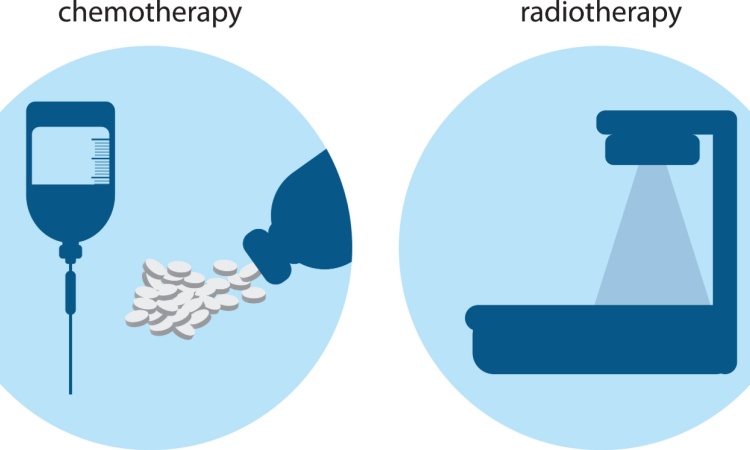Chemotherapy vs Radiotherapy: Key Differences
Chemotherapy vs Radiotherapy: Key Differences

Getting diagnosed with a life-threatening condition like cancer can feel overwhelming. The diagnosis affects not only you going through it, but also your loved ones. Cancer can impact your daily life and often requires long-term care and treatment. While there are different ways to treat it, two of the most common and effective methods are radiotherapy and chemotherapy. Let’s take a closer look at these treatment options and how they differ.
What is Chemotherapy?
Chemotherapy, or chemo, is a type of cancer treatment that uses strong medicines to kill cancer cells. These medicines are usually given through a vein (IV) or taken as pills.
Once in the body, chemo travels everywhere through the bloodstream. It works by attacking cells that grow and divide quickly, like cancer cells. However, some healthy cells in the body, such as those in your hair, mouth and stomach, also grow quickly. Therefore, chemo can harm these healthy cells too, leading to side effects like hair loss or feeling sick.
What is Radiation Therapy?
Radiation therapy is a type of treatment that uses high-energy rays (like X-rays) to kill cancer cells. Unlike chemo, which goes all through your body, radiation therapy is focused on one specific area, right where the cancer is. It works by damaging the DNA inside cancer cells so they can’t grow or spread.
During the treatment, doctors aim the radiation very carefully to kill the cancer cells while avoiding as much harm as possible to the healthy cells nearby. Some side effects can still happen, but they usually only affect the area being treated.
Difference Between Radiotherapy and Chemotherapy
The following are the differences between radiotherapy and chemotherapy:
| Parameters | Chemotherapy | Radiotherapy |
|---|---|---|
| Definition | Chemotherapy uses strong medicines to kill cancer cells. These medicines are usually given through a vein (IV) or taken by mouth as a pill. | Radiation therapy uses high-energy rays to kill cancer cells in a specific part of the body. In some cases, a small device is placed inside the body near the tumour. |
| Type of treatment | Chemotherapy is a whole-body treatment in which the medicine travels through the bloodstream to reach cancer cells all over the body. | Radiotherapy is a localised treatment. It focuses only on the part of the body where the cancer is located. |
| How it works | Chemotherapy uses special drugs that kill cells that are growing and dividing quickly. | Radiation therapy uses high-energy rays to damage the DNA of cancer cells. This either stops them from growing or causes them to die. |
| Effect on the body | Chemotherapy affects the entire body, so it can also harm some healthy cells that divide quickly, like those in the hair, skin and digestive system. | Radiation therapy mostly affects the area being treated. It may affect some nearby healthy tissues, but not the rest of the body. |
| Common side effects | Chemotherapy can cause side effects like hair loss, lethargy, nausea and low blood cell counts. | Radiation therapy may cause skin changes, tiredness or swelling, but usually only in the area being treated. |
| Treatment duration | Chemotherapy is often given over several weeks or months, with sessions spaced out over time. | Radiotherapy sessions are usually much shorter and can take just a few minutes each day, often over several weeks. |
Side Effects of Chemotherapy
Some common side effects of chemotherapy are:
• Fatigue:
Chemotherapy often leads to significant fatigue, leaving patients feeling persistently tired even after adequate rest or sleep.
• Hair loss:
Certain chemotherapy drugs can damage hair follicles, resulting in partial or complete hair loss.
• Decreased blood cell counts:
Chemotherapy can affect the bone marrow, reducing the production of blood cells and platelets.
• Nausea and vomiting:
These are frequent side effects of chemotherapy but are often manageable with prescribed anti-nausea medications.
Side Effects of Radiotherapy
The following are some side effects of radiotherapy:
• Skin reactions:
Radiation can cause skin changes in the treated area, such as dryness, redness, irritation, peeling or blistering.
• Fatigue and stiffness:
The treatment can also cause a general sense of tiredness and localised muscle stiffness, especially toward the end of the course.
• Swelling (lymphedema) :
Radiation can sometimes lead to swelling due to fluid buildup, particularly if lymph nodes were affected during treatment or surgery. This is less common with modern techniques.
Conclusion
Both chemotherapy and radiation therapy are used to treat cancer, but they work in different ways. The right treatment depends on the type of cancer, where it is and the person’s overall health. Sometimes, doctors use both treatments together to get the best results. Although these treatments can cause side effects, they stop the cancer from growing and help you feel better.
Since cancer treatments can be expensive, it is important to have your health insurance with critical illness cover for financial protection during unforeseen medical emergencies.
Disclaimer: The above information is for illustrative purposes only. For more details, please refer to the policy wordings and prospectus before concluding the sales.
RELATED ARTICLES
Difference between OPD and Day Care Treatment
Chemotherapy Benefits in Cancer Treatment
Chemotherapy vs Hormone Therapy Explained
Radiation Therapy Cost: Pre & Post Treatment Breakdown
Chemotherapy Costs and Top Hospitals in Mumbai










 Health Insurance
Health Insurance  Travel Insurance
Travel Insurance  Car Insurance
Car Insurance  Cyber Insurance
Cyber Insurance  Critical Illness Insurance
Critical Illness Insurance
 Pet Insurance
Pet Insurance
 Bike/Two Wheeler Insurance
Bike/Two Wheeler Insurance  Home Insurance
Home Insurance  Third Party Vehicle Ins.
Third Party Vehicle Ins.  Tractor Insurance
Tractor Insurance  Goods Carrying Vehicle Ins.
Goods Carrying Vehicle Ins.  Passenger Carrying Vehicle Ins.
Passenger Carrying Vehicle Ins.  Compulsory Personal Accident Insurance
Compulsory Personal Accident Insurance  Travel Insurance
Travel Insurance  Rural
Rural 











